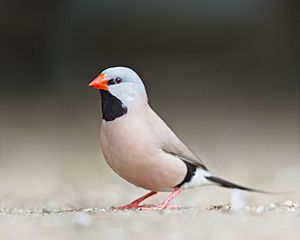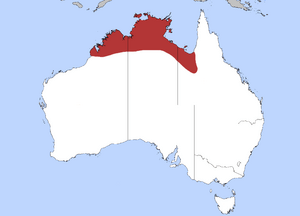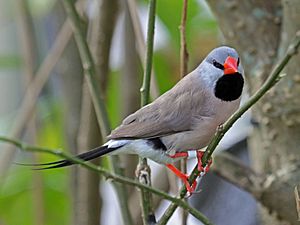Long-tailed finch facts for kids
Quick facts for kids Long-tailed finch |
|
|---|---|
 |
|
| Conservation status | |
| Scientific classification | |
 |
|
| Distribution |
The long-tailed finch (Poephila acuticauda) is a common species of estrildid finch found in northern Australia. You can find it from the Kimberley region to the Gulf of Carpentaria. This bird is mostly fawn-colored, which is a light brownish-yellow. It has a pale grey head and a clear black bib on its throat. Its eyes are also a striking black. It lives in dry, grassy areas called savannahs in Australia. People also like to keep it as a pet bird.
Contents
About the Long-Tailed Finch
How it Got its Name
The long-tailed finch was first described by a bird expert named John Gould in 1840. He gave it the scientific name Amadina acuticauda. The first bird specimen was collected by Benjamin Bynoe. He was a surgeon on the ship HMS Beagle near Derby, Australia. This finch is one of three species in a group of birds called Poephila. It belongs to the finch family called Estrildidae.
Different Kinds of Long-Tailed Finches
Scientists have noticed that long-tailed finches look a bit different depending on where they live. These slight differences led to them being divided into two main groups, called subspecies. A study in 2005 showed that these two groups separated about 340,000 years ago. Their ancestors also split from the black-throated finch about 600,000 years ago.
Common Names for the Finch
This bird has many common names. People often call it the long-tailed finch or just "longtail." Other names include blackheart finch, shaft-tail finch, and orange-billed finch. Sometimes it's called a grassfinch. One subspecies, Poephila acuticauda hecki, is known as Heck's grassfinch or Heck's longtail. These birds have red beaks. The other subspecies, which has orange or yellow beaks, is usually just called the long-tailed finch.
What the Long-Tailed Finch Looks Like
An adult long-tailed finch is about 160 millimeters (about 6 inches) long. Males usually weigh between 13.5 and 16.2 grams. Females are a bit lighter, weighing from 11.4 to 17.6 grams.
Key Features
This finch has a very noticeable round black bib on its throat and upper chest. It also has a long, pointed black tail. Its upper body is pinkish-brown, and its lower body is lighter. It has a grey head, a white patch near its ears, and black markings around its eyes. There are black patches on its sides, and its rump (backside) and under-tail feathers are white.
Beak Color and Sex Differences
The beak color of adult long-tailed finches can be red, orange, or yellow. Males and females look very similar. Females might be slightly duller in color and have a slightly smaller bib. On average, females have shorter wings and tails than males. However, their sizes often overlap. It's hard to tell males and females apart just by looking at their feathers. Young finches have black beaks and shorter tail feathers. The two subspecies are mainly told apart by their beak color. The western group has yellow beaks, while the eastern group (P. acuticauda hecki) has red beaks.
Life and Habits
Social Life
Long-tailed finches usually form simple pair bonds. This means a male and female stay together. Sometimes, you might see them in small family groups or flocks. The pairs stay close to each other during their daily activities. They use songs to identify themselves to their partners. They also use a special "distance call" to stay in touch.
Courtship and Mating
When a male long-tailed finch meets an unfamiliar bird, he might do a courtship display. He stands tall and sings before trying to mate. Sometimes, new males won't sing to show their sex when they meet a group. Scientists think this might help them avoid trouble and be accepted into the group. This could help them find a mate later.
Nesting and Reproduction
Long-tailed finches build their nests in natural hollows of trees. They also use lower plants like clumps of grass or shrubs. If trees are available, the nest can be high up, sometimes over 4 meters (13 feet) off the ground. They often choose eucalyptus trees and pandanus plants.
Building the Nest
Breeding nests are built very carefully from grass. The outside layer uses wider blades of grass, about 150–200 mm (6–8 inches) long. The inside chamber has a soft cup woven from fine stems and seed-heads. They also use soft plant fibers and sometimes feathers to line the inside. The whole nest can be 180 to 230 mm (7–9 inches) long and made of up to 500 pieces. The entrance is shaped like a bottle or funnel, about 50 to 100 mm (2–4 inches) long. Nests used for sleeping outside the breeding season are simpler.
Eggs and Young
Both parents share the job of finding food. There has been one report of older chicks helping their parents raise the next group of young. This is called cooperative breeding and is rare for Australian finches. A group of eggs, called a clutch, usually has four to six dull white oval eggs. Each egg is about 17 x 12 mm (0.7 x 0.5 inches). The eggs hatch after 13 to 17 days.
Where They Live
The long-tailed finch lives in open woodlands across northern Australia. Their home stretches from Derby in the northwest Kimberley region to the Leichhardt River in northwest Queensland. Their total habitat area is very large, estimated to be between 1,000,000 and 10,000,000 square kilometers. The IUCN says that this species is of least concern. This means their population is stable and not currently at risk.
Keeping Long-Tailed Finches as Pets

Long-tailed finches can adapt well to living with people. However, they need a large outdoor cage called an aviary to be healthy, not just a small cage. It's also important to keep them away from damp conditions. Australia has banned the export of these birds. This means they can be quite expensive in places like the UK.
Breeding in Captivity
During the breeding season, it's best to keep a pair of long-tailed finches by themselves. They can become aggressive towards other small finches. They breed easily in captivity, sometimes having two groups of young each year. They usually live for about 5 to 8 years. If Heck's grass finches (P. a. hecki) breed too much, it can harm their health. To prevent this, owners might separate the males and females during winter.
Popularity
By the 1930s, these finches were well-known in aviaries. People liked them because they were strong birds with interesting behaviors and a nice look. The yellow-billed subspecies was first successfully bred in captivity in 1897. The red-billed grass-finch started reproducing in English aviaries about ten years later. These finches also bred in Australia, even at the Australian Museum. Today, long-tailed finches are popular among bird lovers in Europe, Asia, North America, and South Africa. They are less common in New Zealand. In Britain, they are the second most common finch, after the Gouldian finch (Erythrura gouldiae).
Origin of the Species
Scientists believe that the finch family Estrildinae, which includes the long-tailed finch, might have first appeared in India. From there, they spread to other parts of the world, like Africa and the Pacific Ocean areas.
Images for kids
See also
 In Spanish: Diamante colilargo para niños
In Spanish: Diamante colilargo para niños







